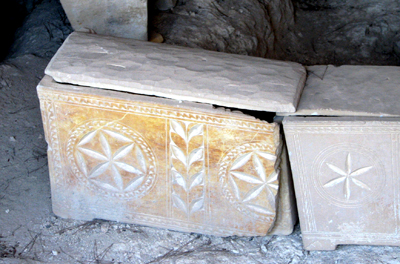
A stone box for storing the bones of a deceased person after the flesh had decayed. It was only used by the wealthy who could afford rock-cut tombs, like the one belonging to Joseph of Arimathea. Poorer people were usually just buried in trenches.

Ossuaries from the tomb in the
compound of Dominus Flevit.
The practice of using ossuaries among the Jews began sometime in the 1st Cent BC, and ended soon after the destruction of the Temple in 70 AD.
One of the most famous, because of the controversy it provoked, was one —first reported in Nov 2002—on which was inscribed "James son of Joseph and brother of Jesus." Bought from an antique dealer in Jerusalem, it created a storm not just because of the inscription but also because the buyer was later charged for forgery and taken to court. Experts remain divided over its authenticity. Another famous ossuary—whose authenticity is not disputed—belonging to the high-priest Caiaphas was discovered in 1990.

FURTHER READING:
Hershel Shank and Ben Witherington III, The Brother of Jesus: The Dramatic Story & Meaning of the First Archaeological Link to Jesus & His Family (New York: HarperSanFrancisco, 2003).
André Lemaire, "Burial Box of James the Brother of Jesus," Biblical Archaeological Review 28 (2002): 24-33, 70.
Jodi Magness, "Ossuaries and the Burials of Jesus and James," Journal for Biblical Literature 124/1 (2005): 121-154.

©ALBERITH